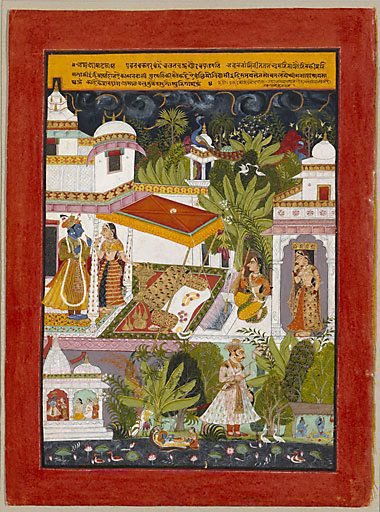Title
The month of Ashadha (June-July), from the series Baramasa series (Songs of the twelve months)
circa 1675
Artists
Unknown Artist
-
Details
- Other Title
- Illustration to a Baramasa (twelve seasons)
- Place where the work was made
-
Bundi
→
Rajasthan
→
India
- Period
- Rajput circa 1500 - 1947 → India
- Date
- circa 1675
- Media categories
- Miniature , Painting , Watercolour
- Materials used
- opaque watercolour with gold on paper
- Dimensions
- 25.7 x 18.0 cm image; 30.3 x 22.3 cm sheet
- Signature & date
Not signed. Not dated.
- Credit
- Margaret Hannah Olley Art Trust 1991
- Location
- South Building, lower level 1, Asian Lantern galleries
- Accession number
- 371.1991
- Copyright
- Share
-
-
About
'Furiously blow the whirlwinds.
Only the demented leave their homes
and loved ones to go out.
Even the wandering ascetic stays put, birds
are afraid to stir out of their nests, let alone
the human being.
Vishnu rests at this time in the
ocean of cream with Lakshmi.
Says the poet Kesavadasa
neither the Vedas nor tradition
approves leaving home
in the month of Ashadha.''Baramasa' or 'Songs of the twelve months' is a poetic genre that describes each of the months of the Indian calendar in terms of love and its rhetoric. Composed in Hindi and other regional languages, these lyric are sung, mostly by women. This verse, from the well known 'Rasikapriya' of Keshavadasa composed in the 1690s, is translated [above].
The iconography of this beautiful Bundi picture is even more complex than the verse. The burden of the poem is expressed largely on the lower panel with the ominous sky at the top. Along the 'ocean of cream' with lotuses and aquatic birds, a temple of Krishna and Radha is on the top left. Then below a banana tree is the sleeping Vishnu beside whom is a prince with bow and arrow whose size completely disproportionate to everything around. Does he represent a demented human or is he returning home? Next in a small hut an ascetic sits on a tiger skin in yogic posture and converses with another.
In the middle ground is a palace scene that is not described in the text. A princely Krishna is being escorted by a maid to the prepared bed with bolsters, flowers and bottles below a canopy. Another maid waits on the other side as Radha appears through a door on the far right for the tryst. It is possible that this composition represents an anticipatory love scene enacted in the mind of the prince returning home at the start of the rainy season when lovers are united.
Pratapaditya Pal, 'Dancing to the flute: music and dance in Indian art', AGNSW, 1997. pg. 88.
-
Exhibition history
Shown in 7 exhibitions
Great gifts, great patrons, Art Gallery of New South Wales, Sydney, 17 Aug 1994–19 Oct 1994
Dancing to the flute: music and dance in Indian art, Art Gallery of New South Wales, Sydney, 12 Jun 1997–24 Aug 1997
Indian Painting, Art Gallery of New South Wales, Sydney, 06 Apr 2001–11 Jun 2001
Intimate Encounters: Indian paintings from Australian collections, Art Gallery of New South Wales, Sydney, 22 Feb 2007–04 May 2007
Margaret Olley: a generous life, Queensland Art Gallery/Gallery of Modern Art, Brisbane, 15 Jun 2019–13 Oct 2019
In one drop of water, Art Gallery of New South Wales, Sydney, 15 Jun 2019–21 Feb 2021
Elemental, Art Gallery of New South Wales, Sydney, 30 Jul 2022–2024
-
Bibliography
Referenced in 4 publications
-
Jackie Menzies (Editor), The Asian Collections Art Gallery of New South Wales, 'Mughals and Maharajas: The Miniature Paintings of Courtly India', Sydney, 2003, 41 (colour illus.).
-
Pratapaditya Pal and Pratapaditya Pal, Dancing to the flute: music and dance in Indian art, Sydney, 1997, 88, 89 (colour illus.). cat.no. 38 See 'Further Information' for text.
-
Haema Sivanesan, Indian painting, 'Indian Painting', verso of poster., Sydney, 2001. cat.no. 2.3
-
Sotheby's London, Islamic and Indian Art. Oriental manuscripts and miniatures., London, Oct 1991, 228 (colour illus.). cat.no. 806
-
-
Provenance
Sotheby's London, Oct 1991, London/England, purchased by the Art Gallery of New South Wales at Sotheby's (London), 'Islamic and Indian Art Sale', 10th and 11th October, 1991, lot 806.
